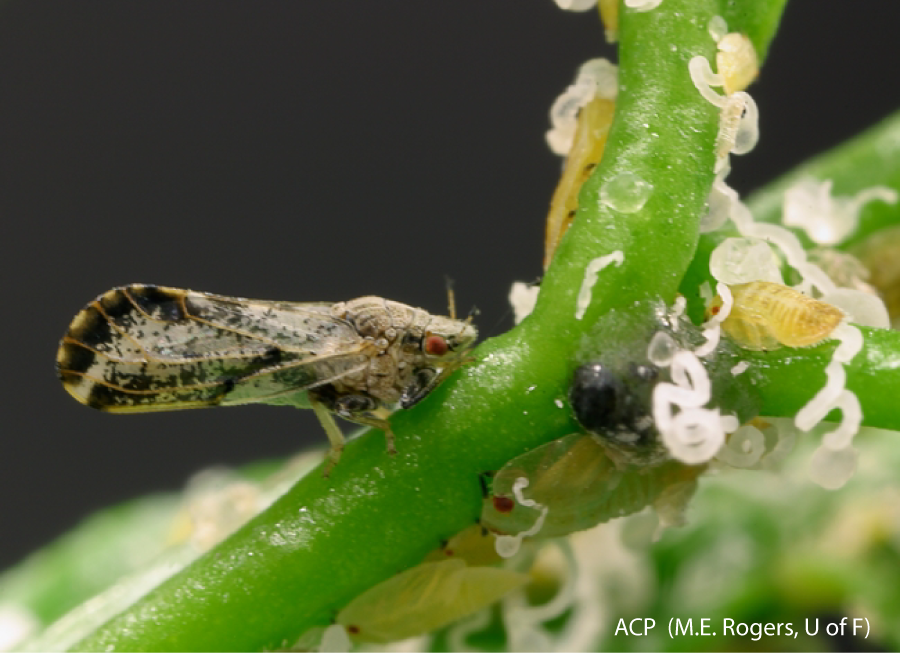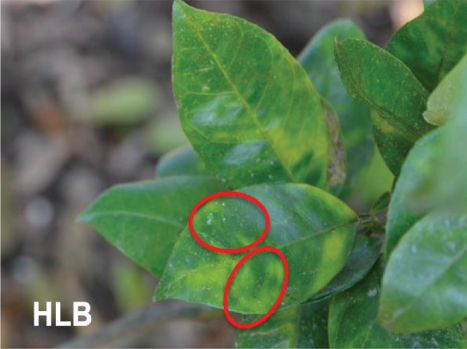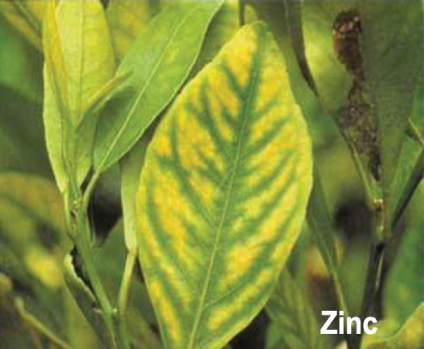Does my citrus tree have Huanglongbing?

Asian citrus psyllid
BY LEO McGUIRE
This time of year, I often receive the question on the Hot Line, “My citrus leaves are yellow, do I have HLB, will my tree die?” This question really scares me. HLB is the easy way to say Huanglongbing, a bacterial disease also known as citrus greening. There is no simple way to test for this disease so your tree could be a carrier for years with few to no symptoms. Therefore, my answer is “Could be. If you are not in a quarantine area, you probably just need to spray on some micronutrients. If your tree is infected, you could also be killing your neighbors’ trees for years.” Here are my recommendations:
First: Learn more about HLB and the insect that transmits the disease.
HLB Is a disease spread by the Asian citrus psyllid (ACP) that has all but wiped out the citrus industry in Florida and Brazil, drastically reducing acreage and production. ACP inject toxins into citrus plant tissues, and eventually causes production of lopsided fruit with a bitter taste. Think about these small insects like you would mosquitos carrying malaria. To learn more, go to: UCIPM HLB or https://ipm.ucanr.edu/PMG/PESTNOTES/pn74155.html

Huanglongbing (HLB)
Second: Identify how close you are to a quarantine area.
You need to find out if you are in the HLB quarantine area. In August 2021, San Diego County had its first quarantine area. Currently, most of Oceanside, some of Carlsbad, an area between Bonsall and Pauma Valley, and a large area in and around Poway are designated as such areas. The State of California declares a quarantine once a tree has tested positive for HLB, and extends a five-mile radius from the positive tree. Restrictions apply to the purchase, sale, and movement of citrus plants and fruit. These restrictions help reduce the spread of the disease.
To find out more go to: https://californiacitrusthreat.org/pest-disease/.
Third: Always control ants. https://ipm.ucanr.edu/PMG/PESTNOTES/pn7411.html. Ants protect Asian Citrus Psyllid (ACP) the carrier of the disease. ACP are very small and hard to see. If they are not transmitting the disease, they cause damage similar to an aphid.

Zinc deficiency
Yellow leaves are common in our area every spring, so don’t panic. Look at: https://ipm.ucanr.edu/PMG/C107/m107bpleaftwigdis.html. As our days get longer, our citrus start to grow before the soil is warm enough to translocate minor nutrients to the new growth. Zinc, iron and manganese deficiencies often cause yellow patterns on both sides of the leaf. A quality micronutrient spray from your local garden center should green these leaves up within weeks of application. Often, if you are just patient, apply citrus fertilizer as recommended on the label and allow your tree to dry out between irrigation, yellow leaves should soon turn green. Remember that to stay healthy, a tree needs proper watering and should be mulched. If your citrus tree is old, not productive, or the fruit just never gets sweet enough, it might be a good time to take it out and plant that avocado tree you always wanted.
If you want to learn more about ACP and HLB go to: https://awm.sbcounty.gov/wp-content/uploads/sites/84/2022/04/ACP-and-HLB-Beth-Grafton-Cardwell-UCR.pdf
Leo McGuire has been a UCCE Master Gardener since 2023.

